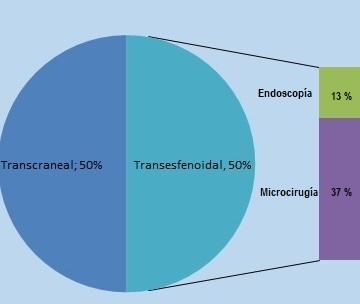Usted está aquí
Peruvian Journal of Neurosurgery
Experience in the surgical treatment of pituitary adenomas at the Guillermo Almenara Hospital in 2019-2020
JOHN VARGAS U, GIAN FRANCO REYES N, FERNANDO PALACIOS S, MARCO MEJIA T, JERSON FLORES C, CAMILO CONTRERAS C, MANUEL LAZÓN A, KENNET LOPEZ G, JOHN MALCA B, JOSE-DANIEL FLORES S, EDUARDO ROMERO V.
Abstract (Spanish) ||
Full Text ||
PDF (Spanish) ||
PDF (English)
ABSTRACT
Introduction: Pituitary adenomas constitute 25% of the primary benign neoplasms of the brain and can be functional or non-functional, or depending on their size they can be microadenomas, macroadenomas, and giant adenomas. They are mainly treated by surgery using a transcranial or transsphenoidal approach.Objective: To know the experience in the surgical treatment of pituitary adenomas in the Guillermo Almenara National Hospital from January 2019 to May 2020.Methods: Descriptive, retrospective, cross-sectional epidemiological study. 84 cases of patients operated on for pituitary adenoma were found. The data was collected from the medical history and images in the hospital's PACS system. Chi-square was applied as a statistical test.Results: Of the total of patients, 50% were operated by transcranial surgery and 50% by transsphenoidal surgery. Hypertension, Cushing's disease, and acromegaly were statistically significant in favor of transsphenoidal resection. 69.05% were macroadenomas in transsphenoidal resection (TSR) and 61.90% in transcranial resection (TCR). In the TSR there were 4.76% of intraoperative complications, and in the TCR it was 19.05%. The total resection grade was greater than 50% in both groups.Conclusions: Pituitary adenomas are a frequent pathology and can be treated by transcranial or transsphenoidal approach, with good resection rates. Prospective studies are required to determine the causal relationship between the variables. Keywords: Pituitary Neoplasms, Acromegaly, Craniotomy, Endoscopy (Source: MeSH NLM)
|



